I flew out of the new LaGuardia Airport terminal 2 weeks after it opened and couldn't believe it was the same airport I hated. Here's what it was like.
Thomas Pallini

- I flew out of the new Terminal B at LaGuardia Airport on a recent trip to Orlando and experienced the new Arrivals and Departures Hall, known as the headhouse, for the first time as a passenger last week.
- Putting it through its paces a regular flyer, the terminal did not disappoint but many of the shops and eateries were closed due to the pandemic.
- Now that LaGuardia has modern facilities, the other positive aspects of utilizing the airport quickly shined through and it was a great experience.
The Arrivals and Departures Hall of the new Terminal B at LaGuardia Airport just opened to passengers on June 13 after four years of construction, marking a new era for the long-forsaken airport. Known as the headhouse, it's the centerpiece of the first major overhaul to LaGuardia's largest terminal since it opened in 1964, replacing the old and congested Central Terminal Building.
Passengers flying on American Airlines, Southwest Airlines, Delta Air Lines, and United Airlines were the first to experience the new building, part of the $5.1 billion project to completely revamp the airport. The terminal itself is only around 80% complete but the first impression for departing passengers will now be a brand-new facility with the most modern infrastructure.
On a recent trip to Orlando on Southwest Airlines and United Airlines to test the social distancing policies of each airline, I flew in and out of the new terminal. I had already visited the terminal before its opening and saw all of its coolest features but now it was time to put it to the test as a regular passenger.
Come take a look at what it's like to fly out of and into the new LaGuardia Airport Terminal B.
I parked my car in the Terminal B garage which directly connects with the terminal via a two-story concourse.
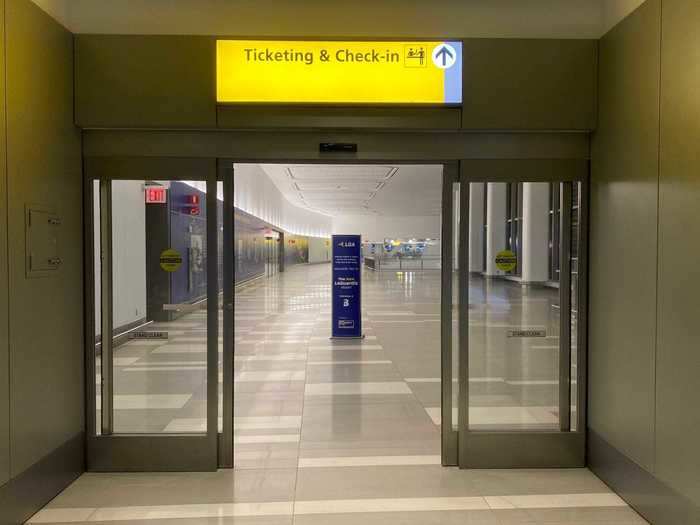
Despite only serving as a thoroughfare between the terminal and garage, the connector is huge with artwork and a timeline history of the airport lining the walls.
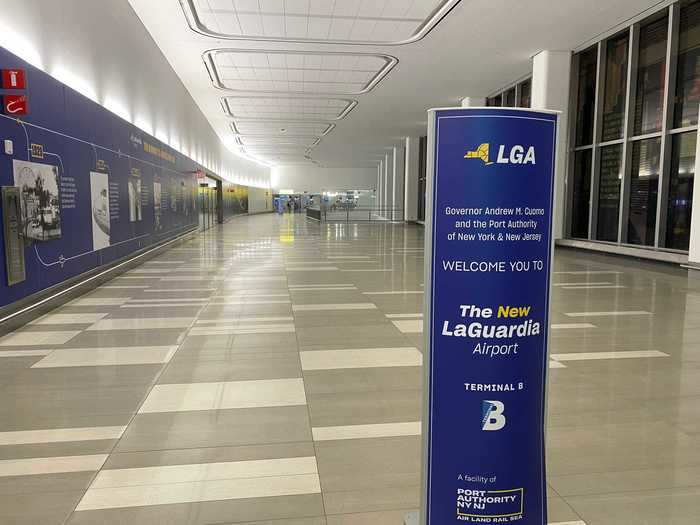
The new building includes scores of safety features due to the ongoing pandemic and face coverings are required for everybody entering the facility.
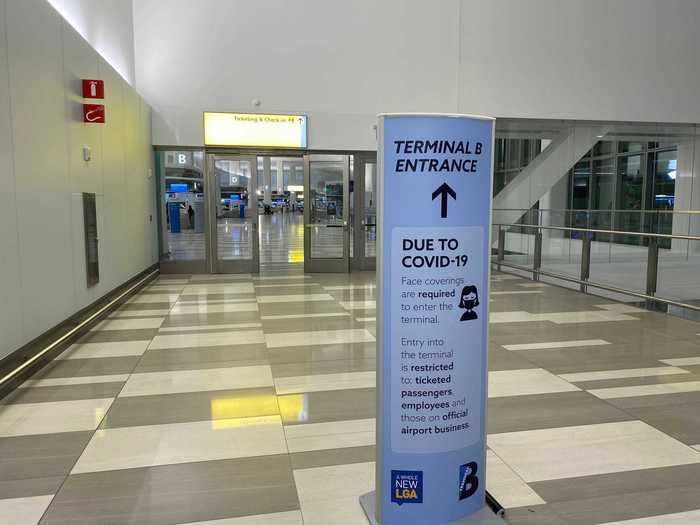
A key safety feature of the terminal was the placement of hand sanitizer dispensers across the building located near most touchpoints including the check-in kiosks and after security checkpoint.
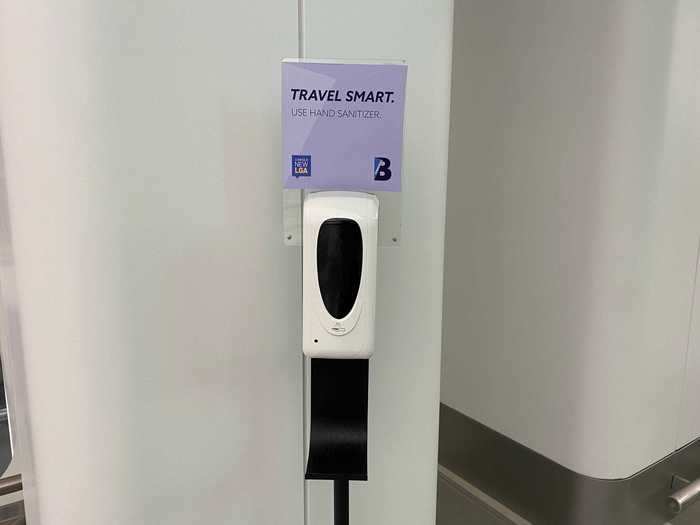
The connector lets out right into the departures level of the terminal without having to step outside into the elements to access the terminal.
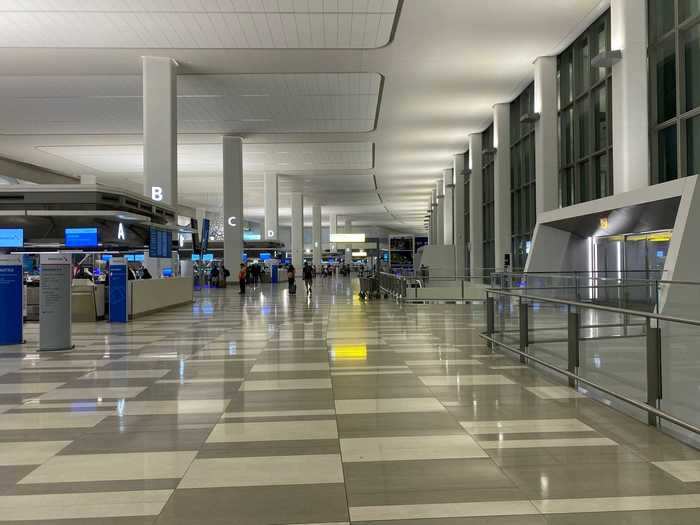
The check-in counter for American Airlines is the closest to the garage and I was flying on Southwest but luckily, I knew the trick to get my boarding pass here instead of having to walk further down.
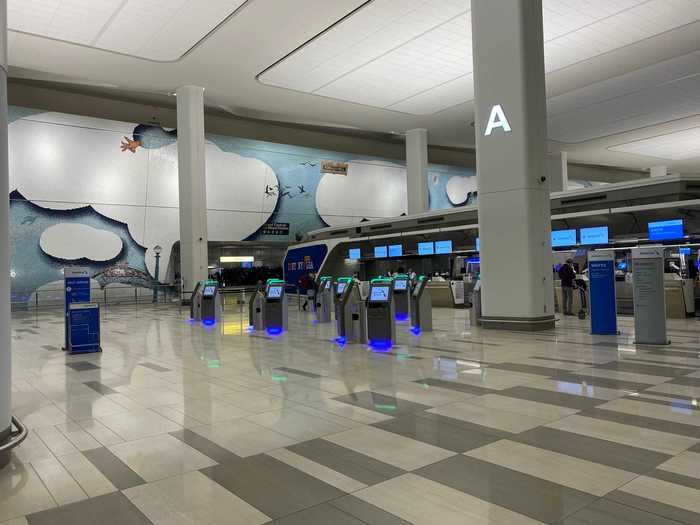
There's an option on the main screen of every kiosk that says "more airline choices" which allows passengers to access the check-in system of any airline at the terminal. Even though I was flying on Southwest, I was still able to get my boarding pass from the American check-in area.
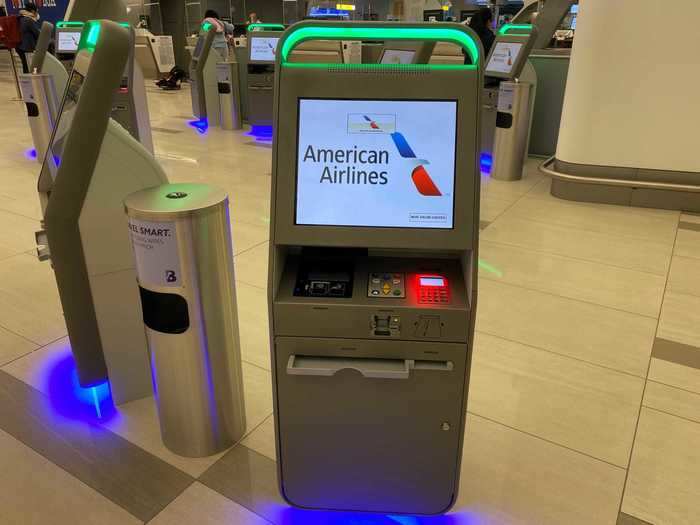
Passengers getting dropped off at the terminal would arrive here at the departures roadway. A key design feature here is that the sidewalk and roadway are level, allowing for an easy transfer from the road to the terminal.

The old revolving doors that felt an inch away from the roadway are replaced by huge entryways with automatic sliding doors.
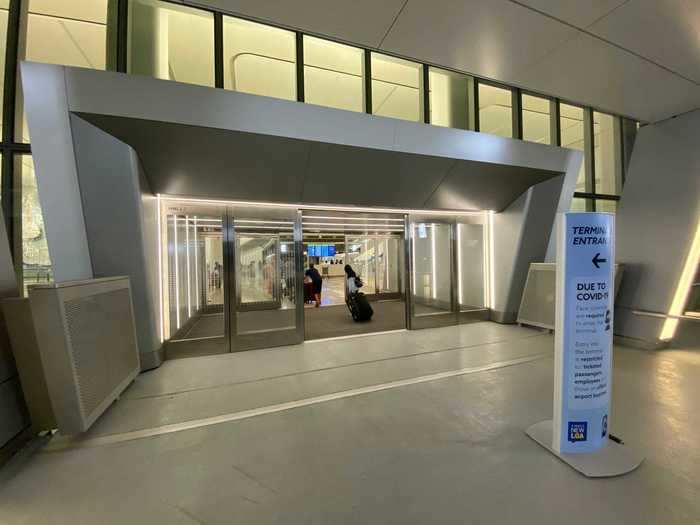
Walking in the terminal feels more like entering a mega international airport than it does the LaGuardia to which most New Yorkers had grown accustomed.
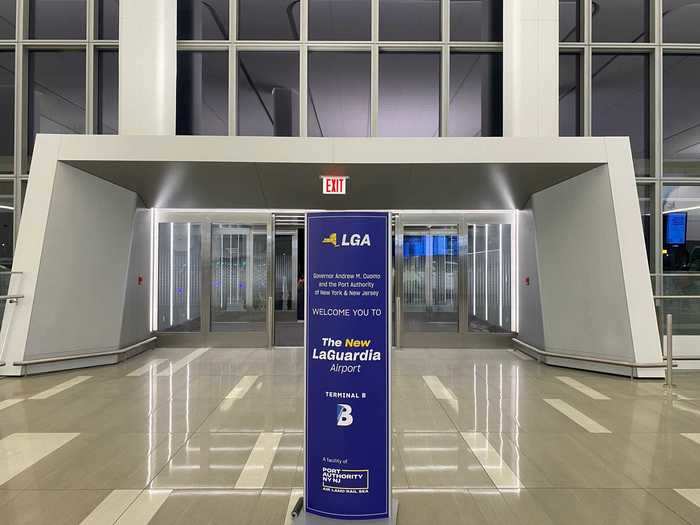
It wasn't even 5 a.m. when I got to the terminal but the facility was beautifully lit, perfectly highlighting the artwork on display.
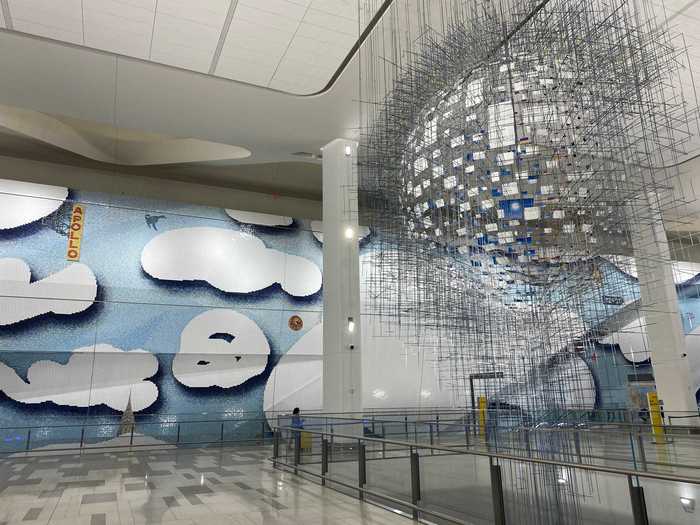
The Arrivals and Departures Hall itself is 850,000 square feet and the check-in area is only one part of the massive four-story building.
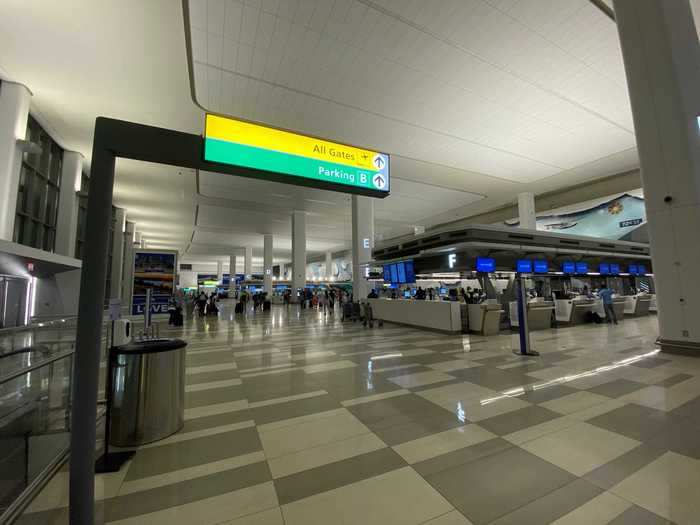
Departing passengers enter the building on the third level. Baggage claim is on the second level and a welcome center is on the first level.
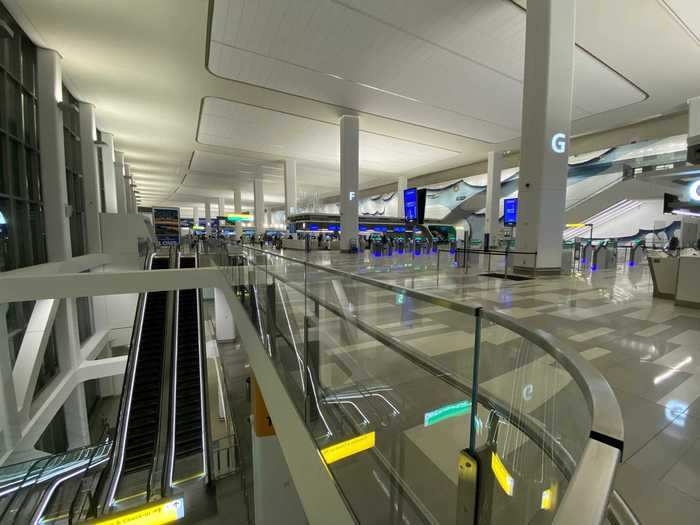
After I printed my boarding passes, I followed the clouds to the security checkpoint.
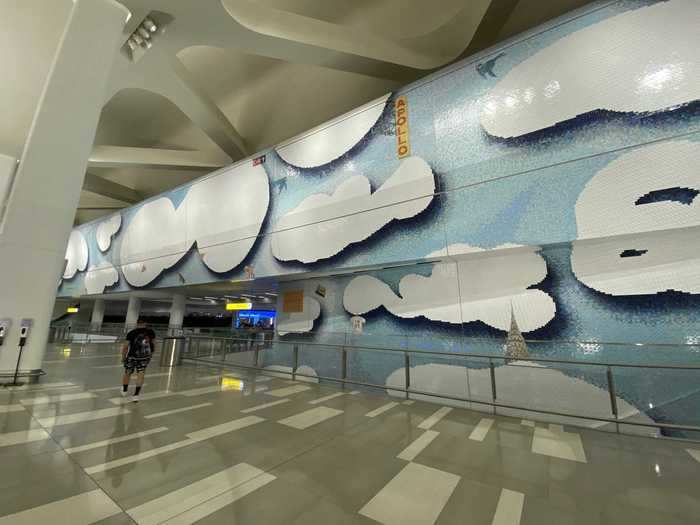
All passengers pass through one checkpoint but with 16 lanes available, there wasn't too much of a size constraint.
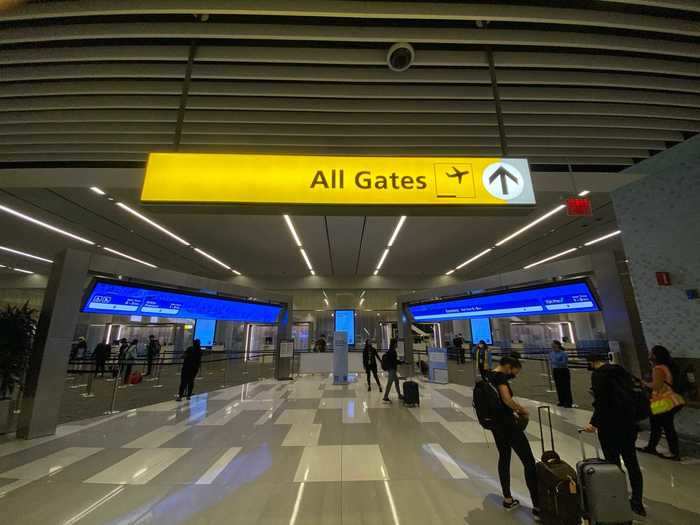
The TSA is still reporting less than 750,000 people are passing through checkpoints across the country every day spread across 500 airports. Here's the lane for TSA PreCheck.
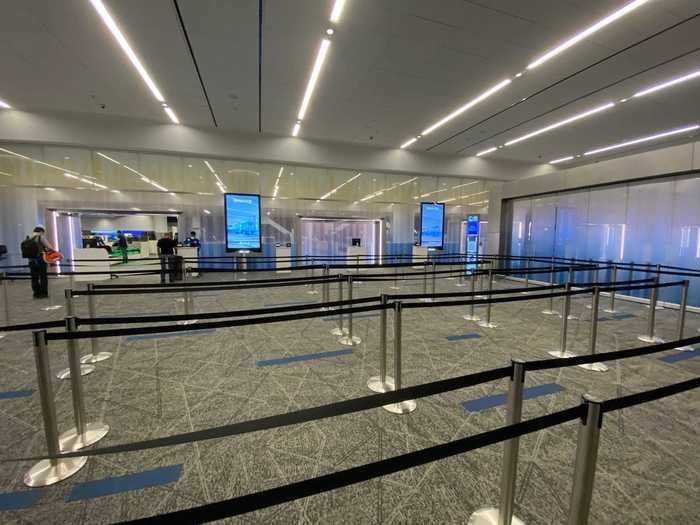
Displays lined the walk informing passengers of what they need to do when they get to the front. No more TSA officers shouting "shoes off, belts off."
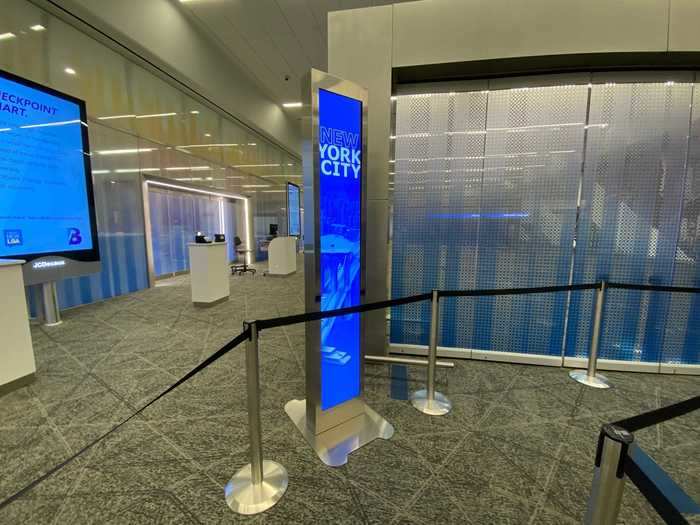
Most of the expansive screening area isn't used as demand is still low but when travel does rebound, peak days at LaGuardia will see the facility used to its maximum extent.
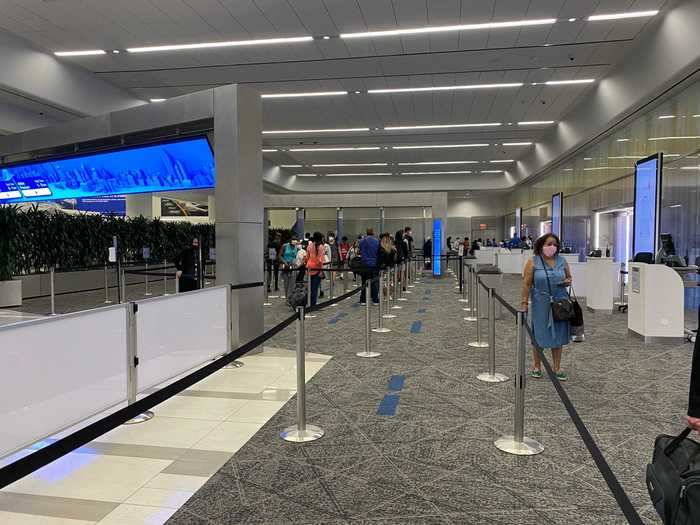
Terminal B is supposed to be employing the new Credential Accreditation Technology that only requires passengers to show their identification to TSA officers but it wasn't being used when I passed through so I had to show my boarding pass.
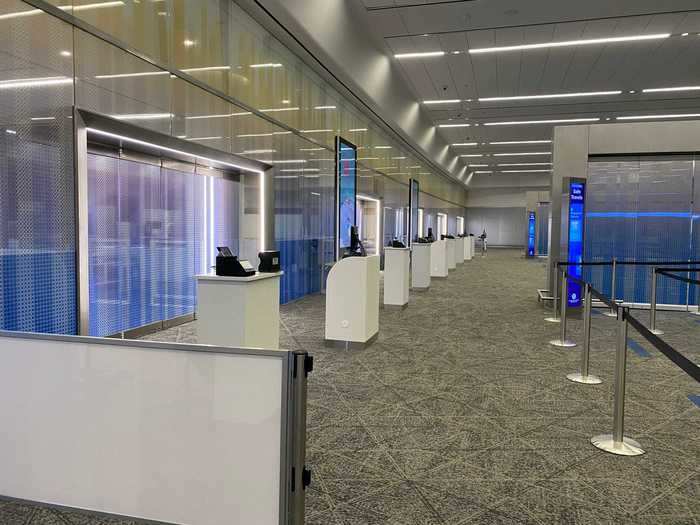
The post-security area offers couches and tables for passengers to reassemble themselves after the screening with no shortage of hand sanitizer dispensers.

Passengers then take the escalator or elevator up to the main retail and dining space before heading to the gate.
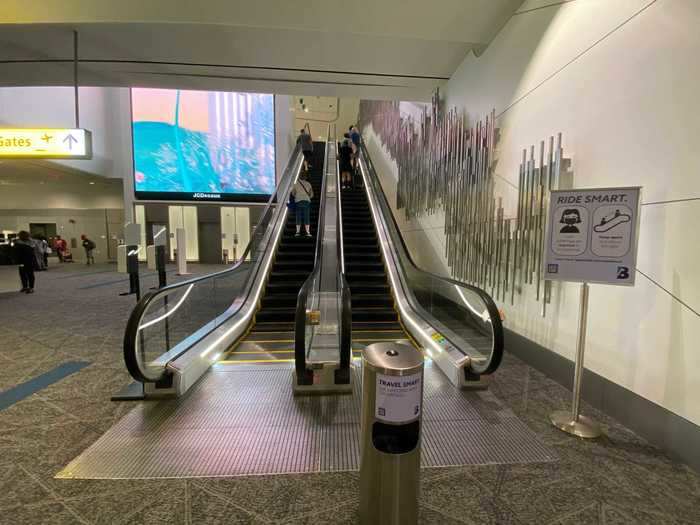
At the top of the escalator and elevator bank, there's a departure board that tells passengers if they should head to the gate or if they have time to hang out.
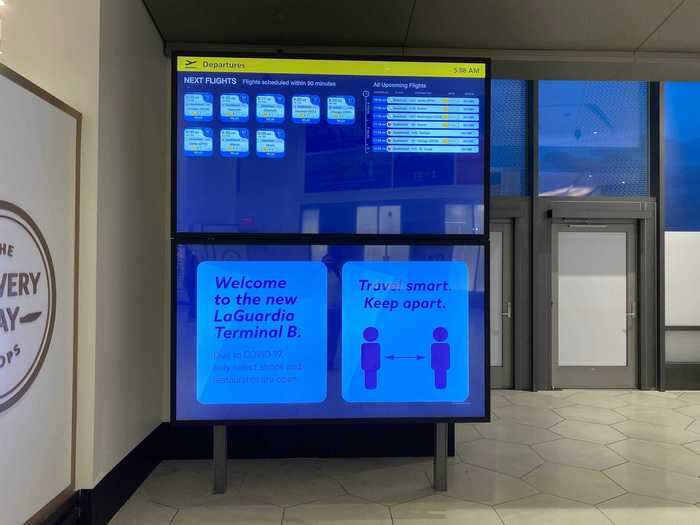
My flight was less than a half-hour from boarding but with the gate only a six-minute walk away, I was told to "relax."
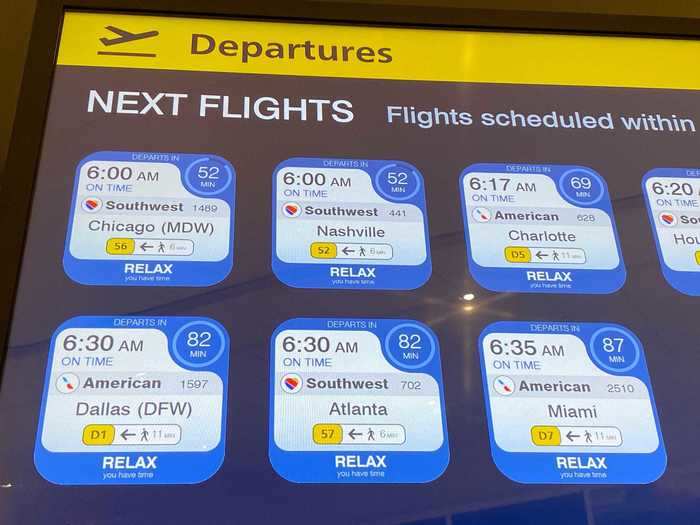
Departure signs are organized by departure time instead of destination and give the walking time to the gate, customized from each board.
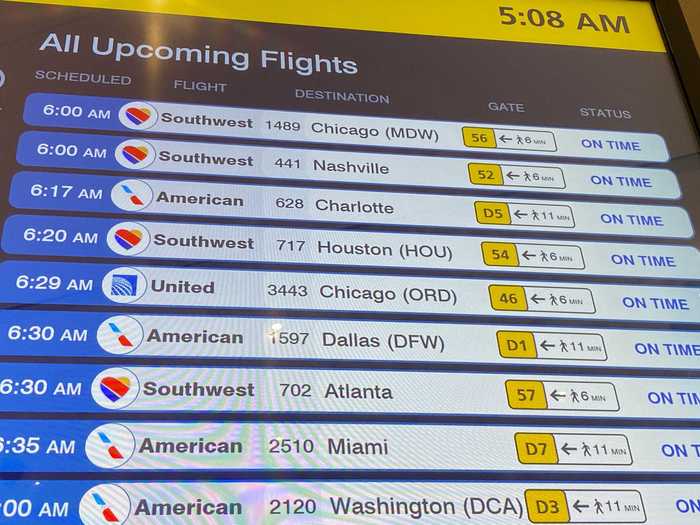
Passengers then have to walk through the Bowery Bay Shop before they can get to the gates, much like how international airports abroad require walking through a duty-free store before going to the gates.
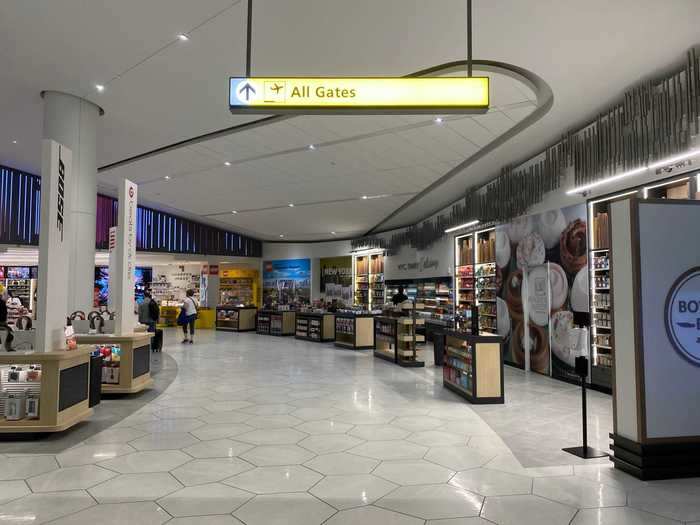
The store is massive with countless brands represented and there's even an LED light display overhead.
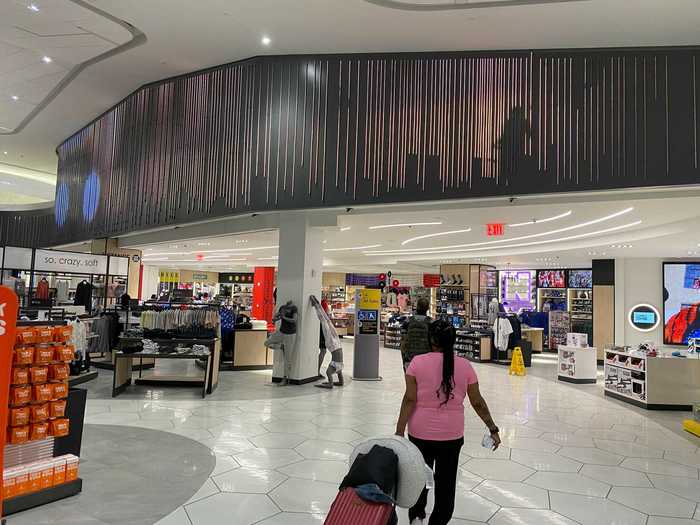
I felt like I was walking through a department store rather than an airport with everything that was on offer.
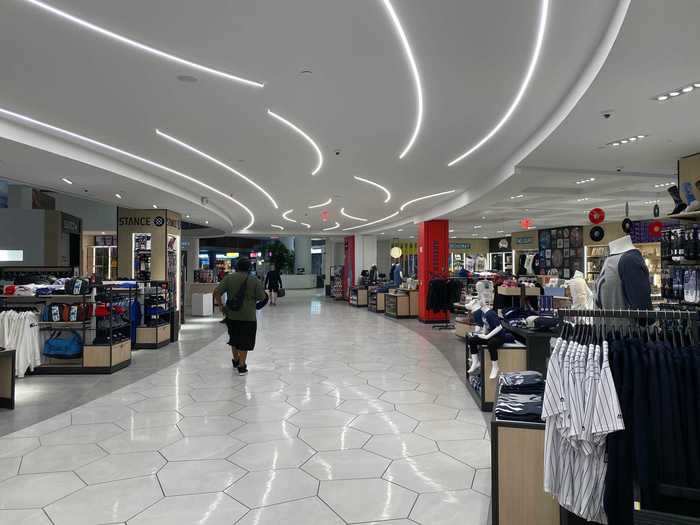
The passageway ends in the heart of the retail and dining space, complete with a fountain in the center almost as if we were in a luxury mall.
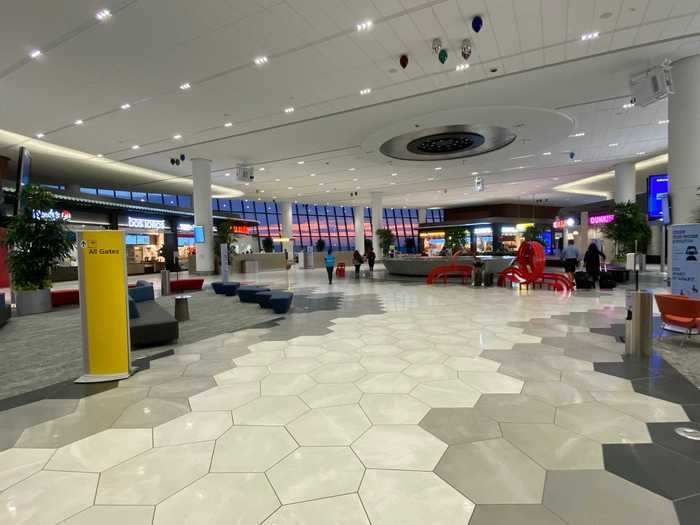
It's a quasi-oval shape with shops on one side and eateries on the other.
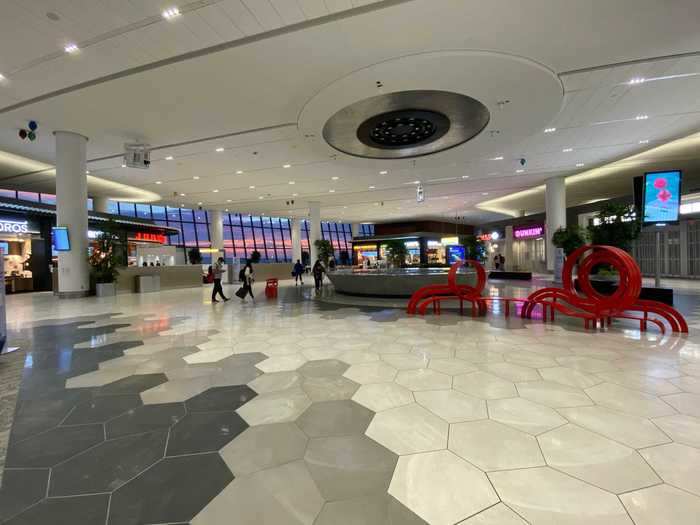
I wouldn't have normally associated LaGuardia with high-end brands like Kate Spade but this is clearly a new era for the airport.
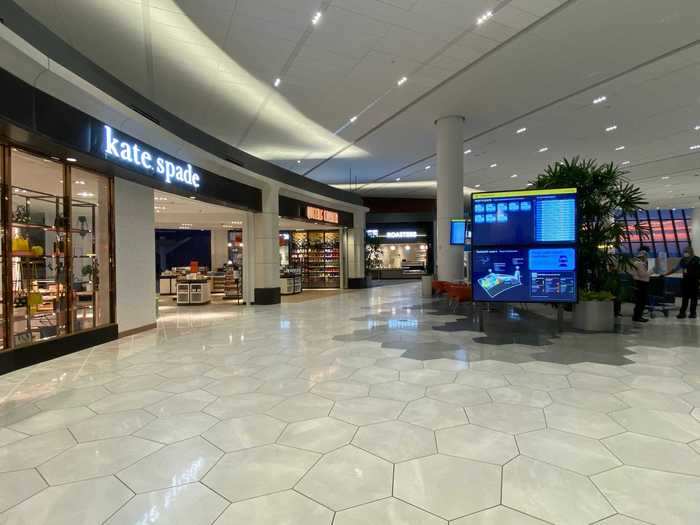
The seating area here isn't expansive but there are plenty of places to take a breather before a flight.
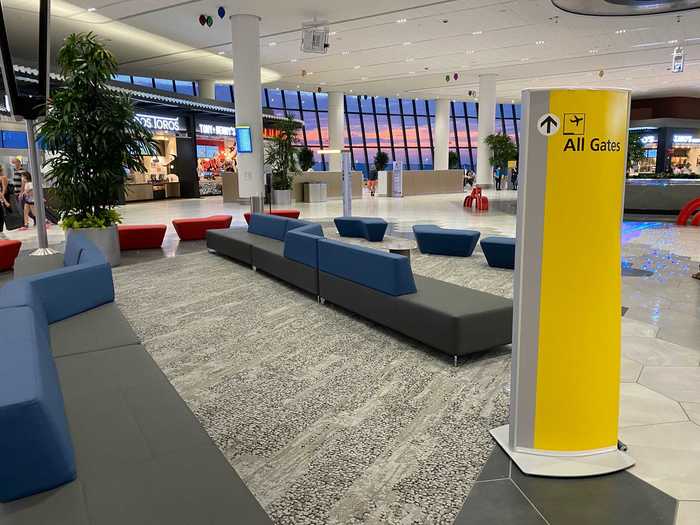
The designers wanted to make the area a place for passengers to hang out before heading to the busy concourses below or even a place to retreat to during a layover or delay.
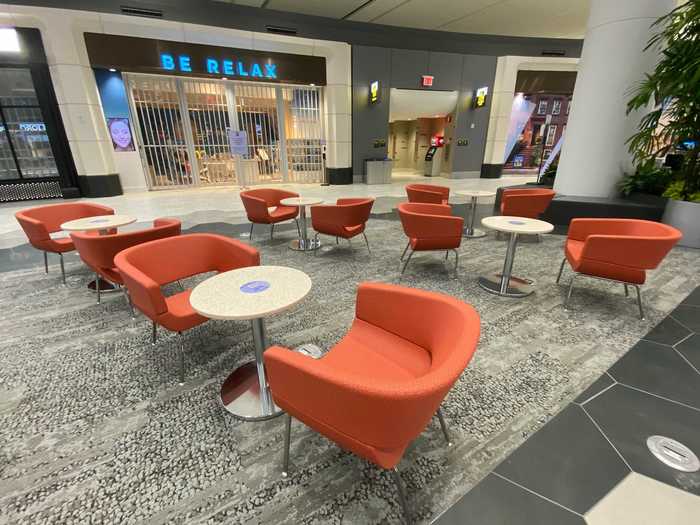
Most of the restaurants and fast food joints were closed, however, because of the pandemic.
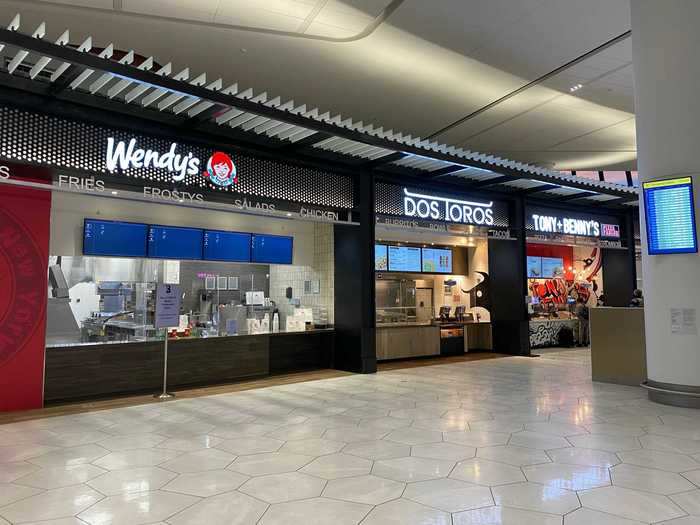
New York City was still in phase 2 and as such, indoor dining was not allowed.
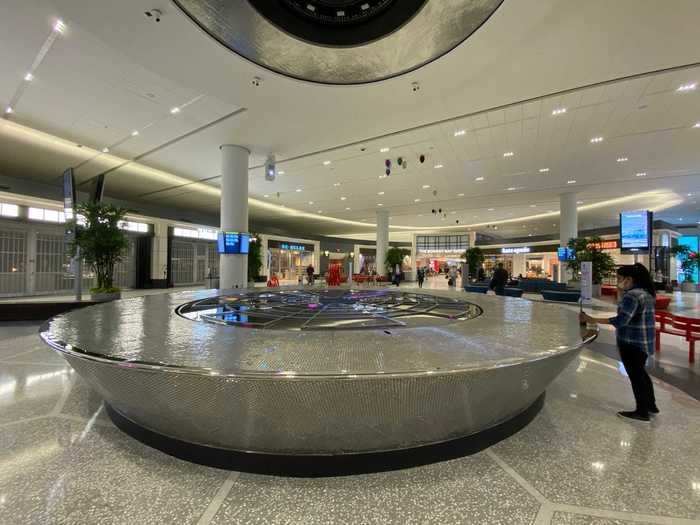
The main dining area had been halved of its normal capacity as tables were spread out by at least six feet to allow distancing. Those hanging out in the area, however, were treated to gorgeous views of the sunrise.
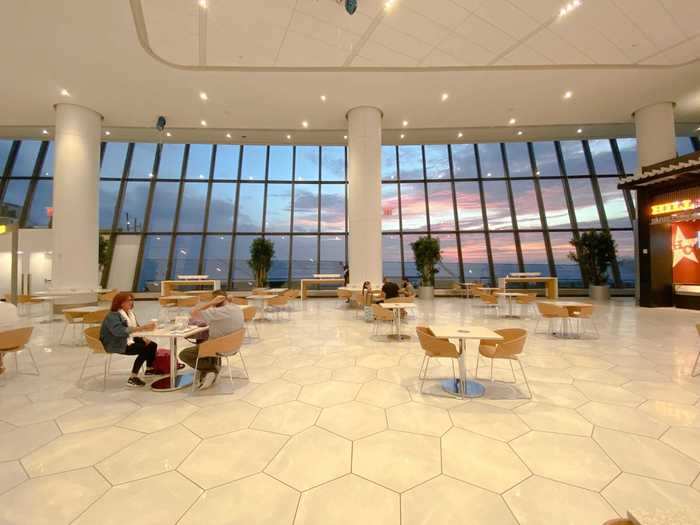
With no reason to stick around, I headed over to my gate in the Eastern Concourse.
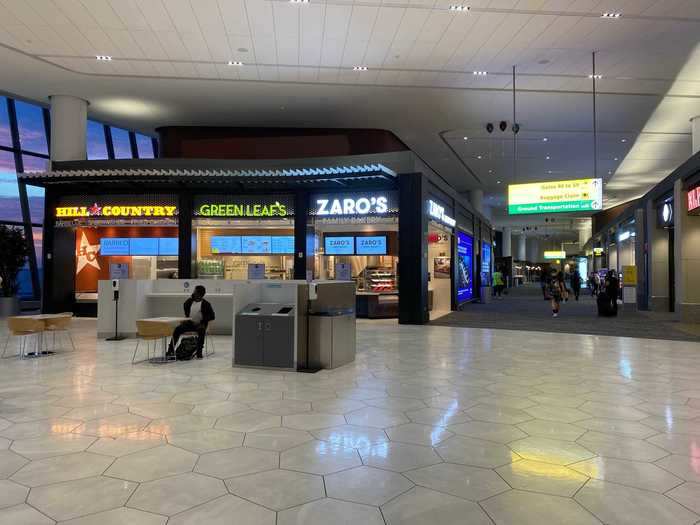
The directional boards said it would be a five-minute walk to my gate, which is long for LaGuardia. The one downside to the new terminal is that it will undoubtedly take longer to get from the curb to the gate.
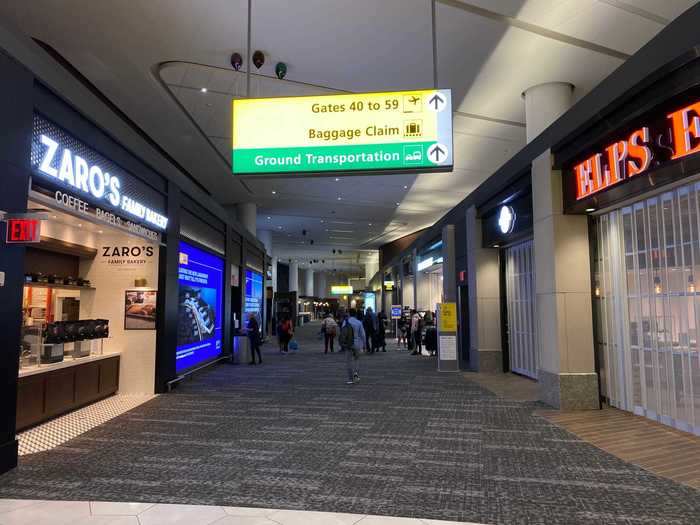
Most shops along the way had introduced a self-checkout option and cashier stands had plexiglass partitions.
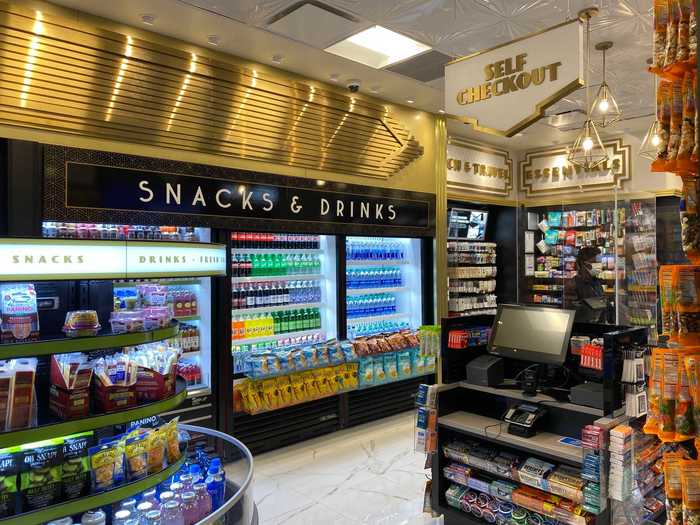
High-end restaurants line the walkway to the concourse including this one, an Italian restaurant and bar named Mulberry Street.
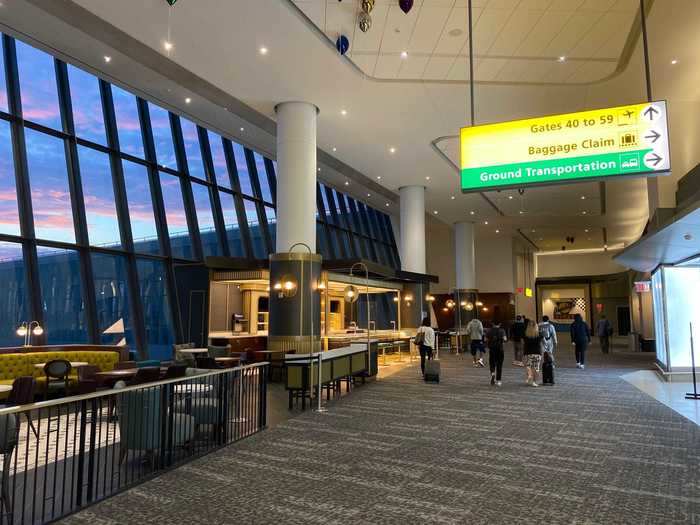
Once construction on the terminal is fully completed, diners will have unobstructed views of aircraft passing below.
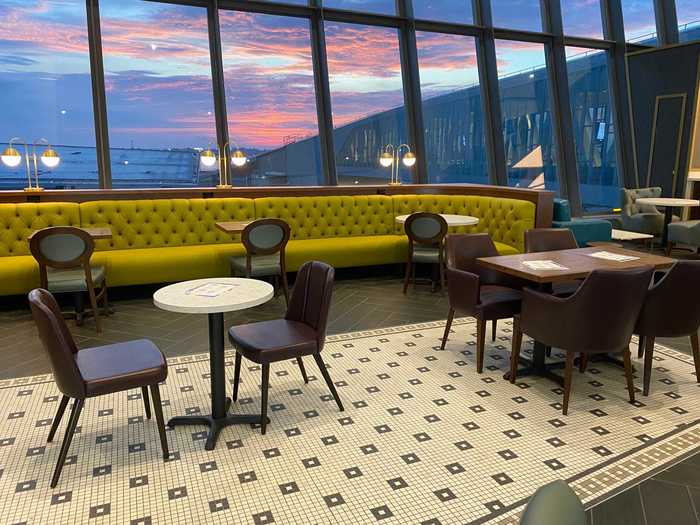
The walk isn't over just yet as we still have to cross the bridge.
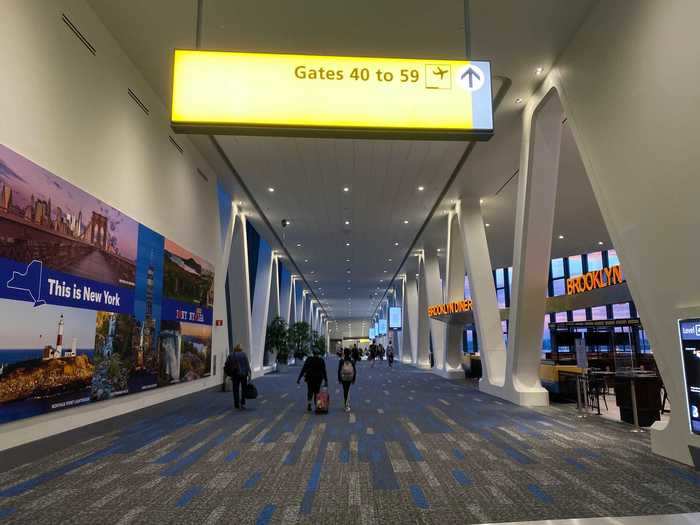
This is one of two air bridges that connect the Arrivals and Departures Hall with the concourses that house the gates.
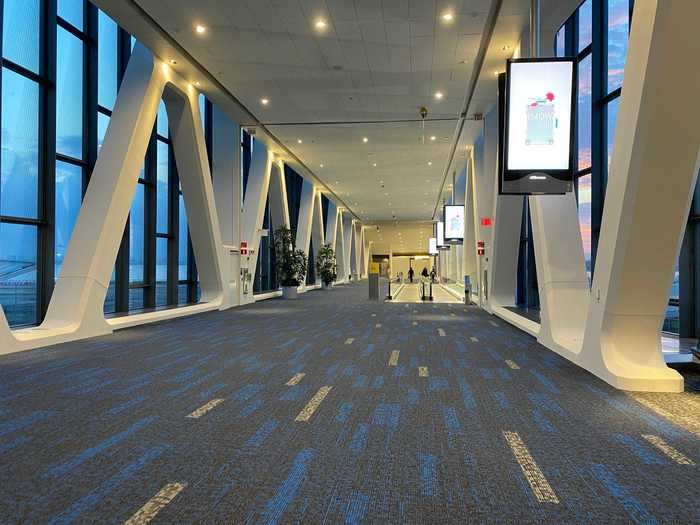
Aircraft will be passing directly under this bridge, which allows for another taxiway to ease congestion. Developers had to get creative as LaGuardia isn't known for its wide open spaces.
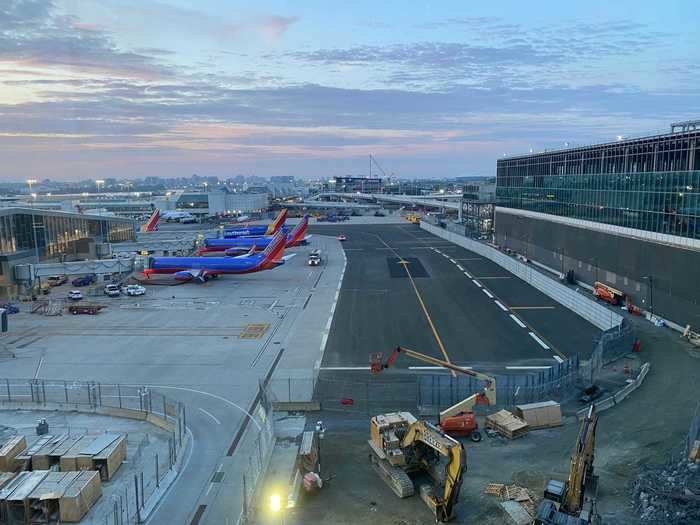
Luckily, there's a moving walkway to help across.
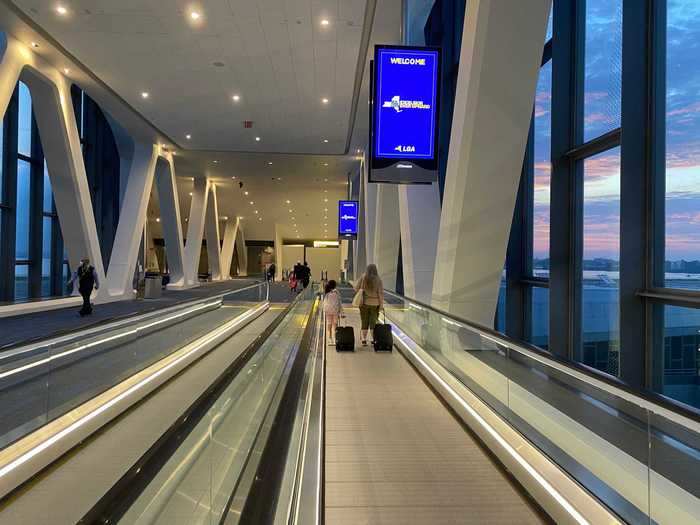
Passengers then descend into the terminal from above, going from the highest point of the terminal to the lowest.
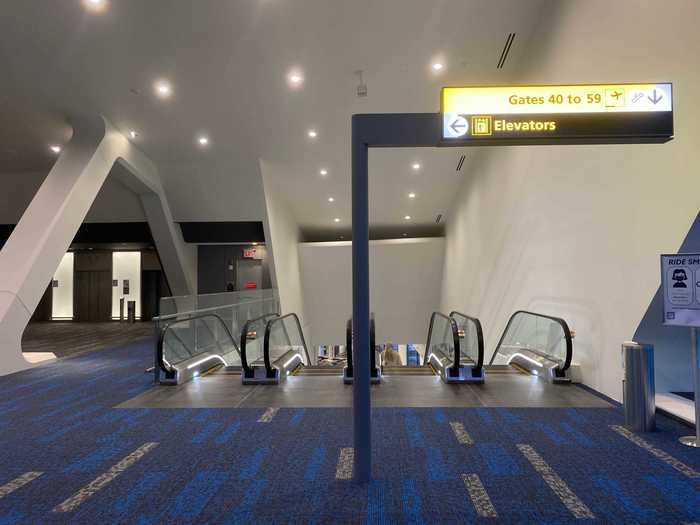
The four-escalator bank brings passengers first to the upper level of the concourse where United and Air Canada have lounges and there are some seating areas.
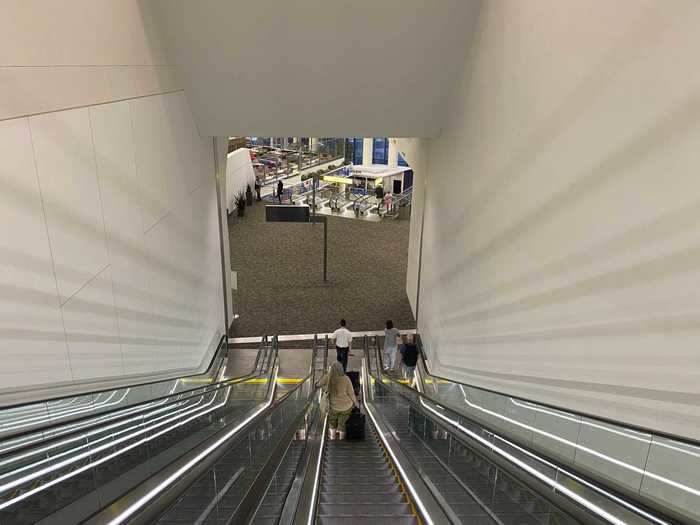
Then, it's just one more escalator ride down to the first floor that houses the gates.
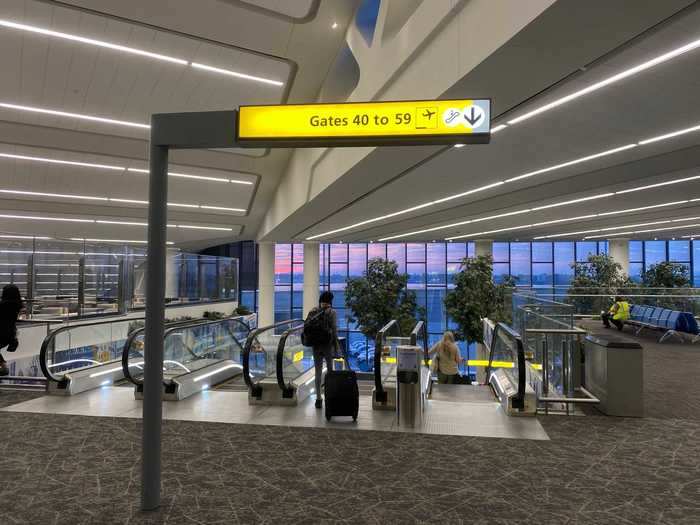
The elevation plays tricks here as you've just gone from being around 90 feet up to what feels like the bottom floor, even though you're still above ground.
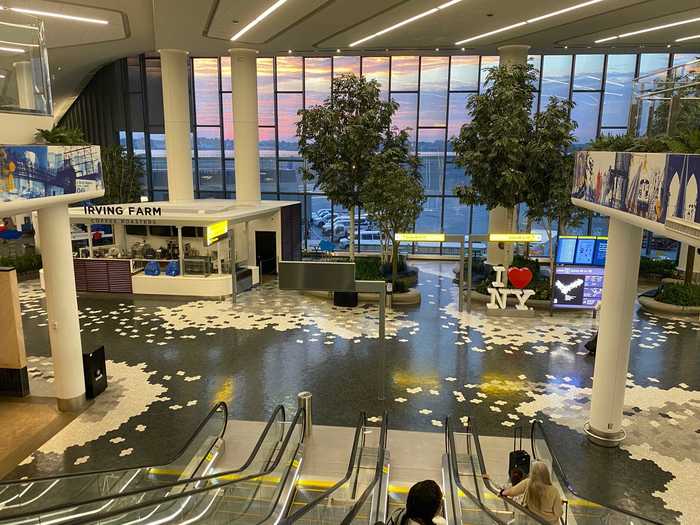
The terminal is almost L-shaped but even the furthest gate is a short walk from the center where the escalator ends.
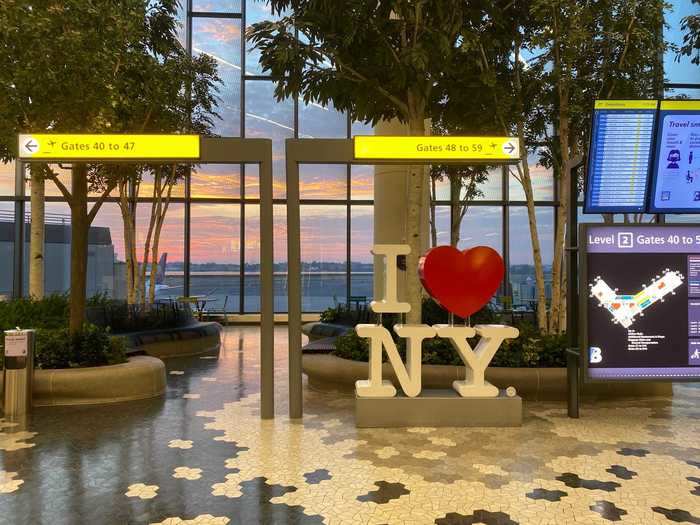
The retail and dining experience continues with fast food places like Shake Shake serving passengers. Most still weren't open either when I departed.
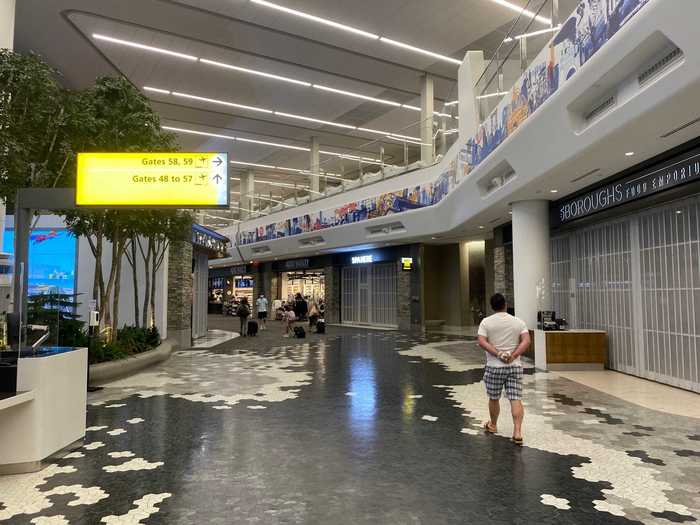
Like the rest of the terminal, the new concourse is night and day from its predecessor in terms of open space and seating availability.
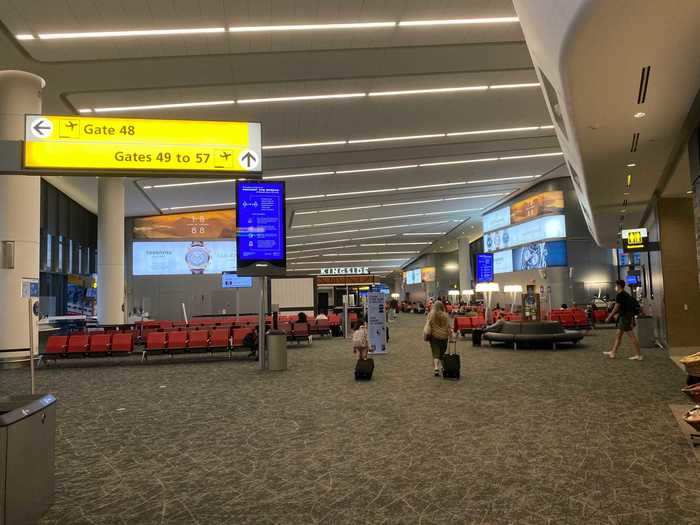
Social distancing wasn't a problem thanks to the rows of seating available.

All of the gates also have plexiglass partitions courtesy of the airport.
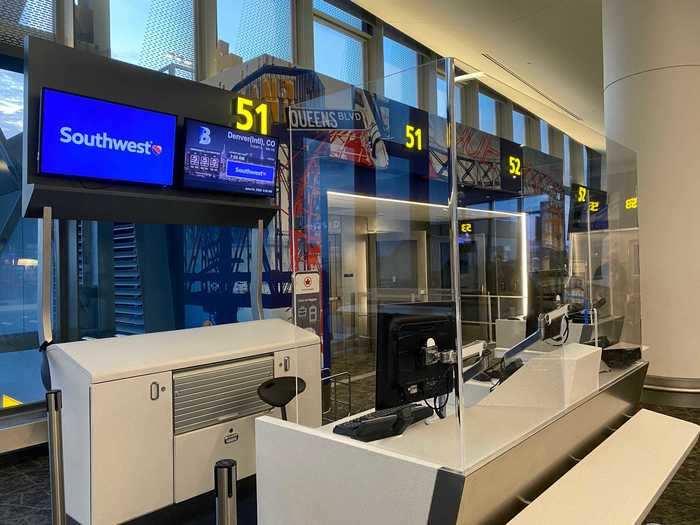
After I boarded my Southwest flight to Nashville, we pushed back and taxied without delay.
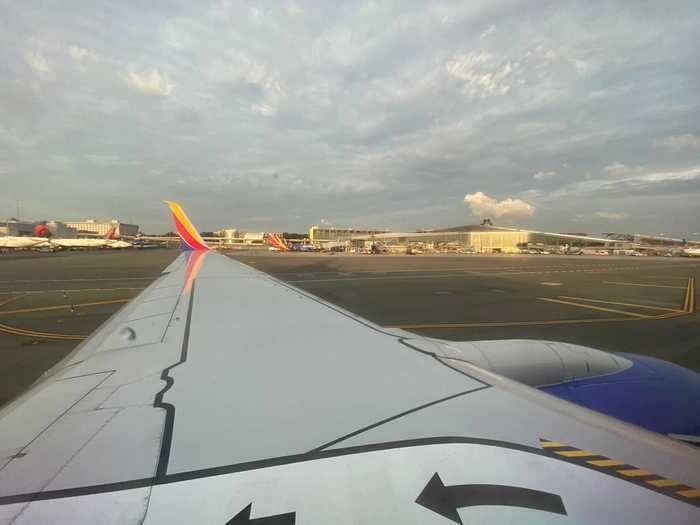
It was a short taxi to the runway before we took off and got to enjoy the perks of flying out of LaGuardia even before the new terminal came: the views.
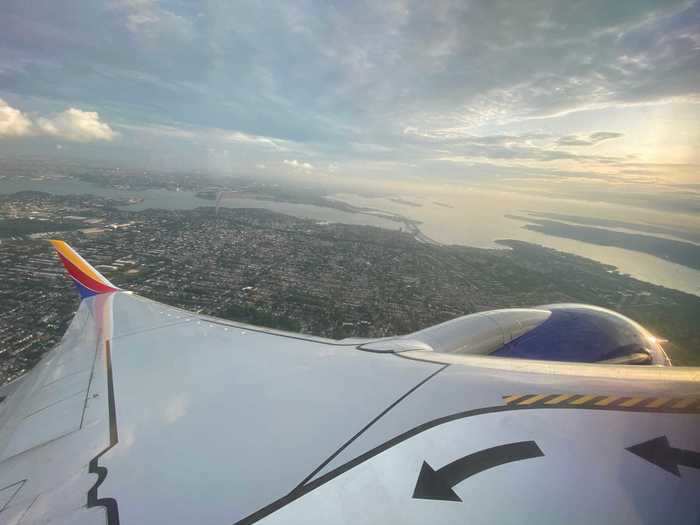
There's the airport just off of the wing.
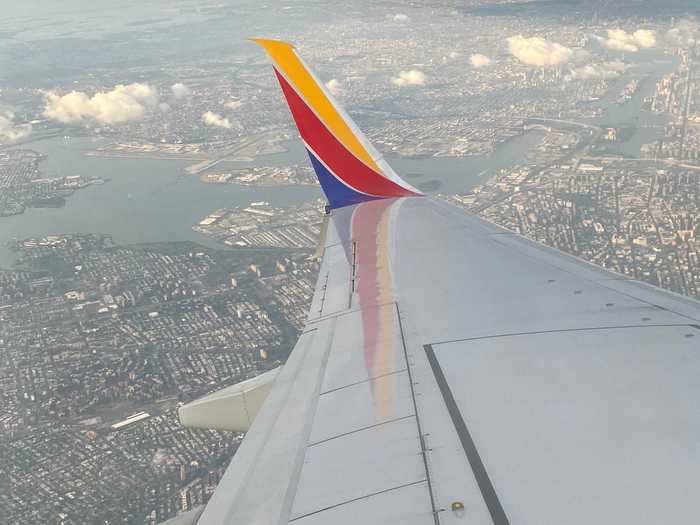
And we were treated to this great view of Manhattan. So far, the new LaGuardia did not disappoint.
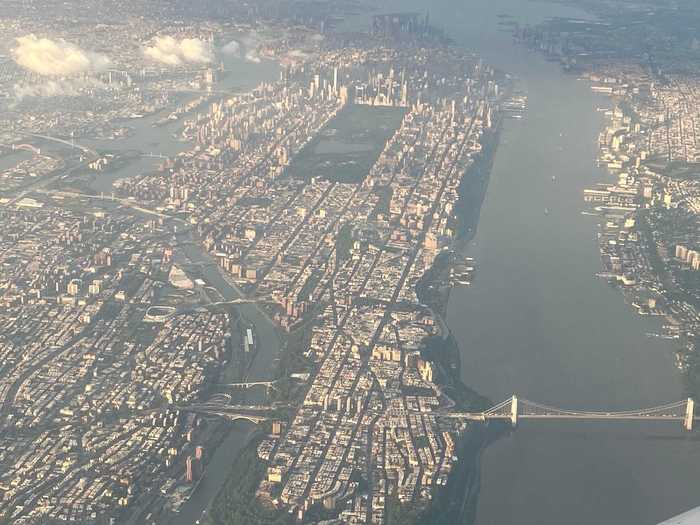
I arrived back at LaGuardia later that day after flying home on United. Our gate was on the other side of the concourse, which had been largely empty.
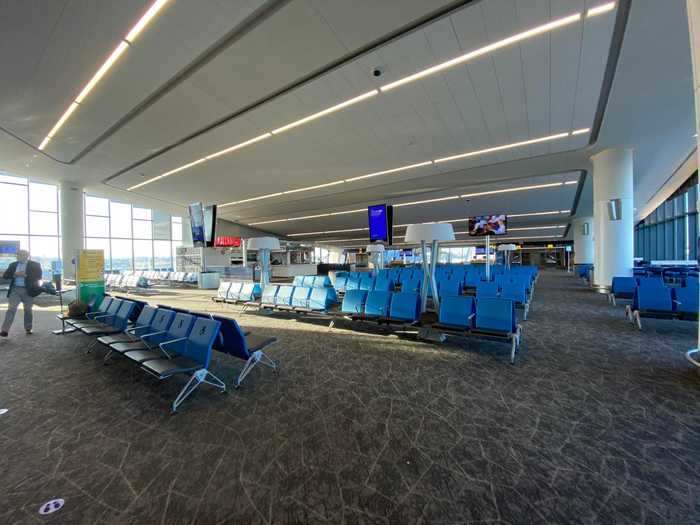
It was the first time I'd arrived at the new LaGuardia and didn't immediately want to rush out.
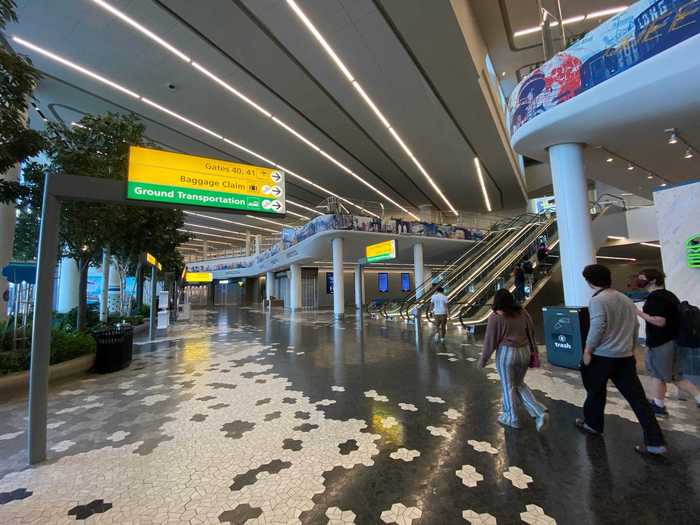
Seeing as all the stores were still closed, however, I headed for the exit. I'd once again ascend to the highest level of the terminal,
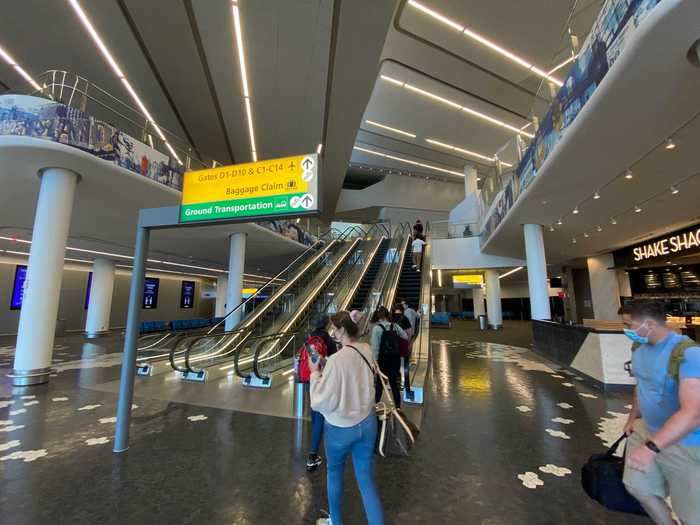
Take two sets of escalators,
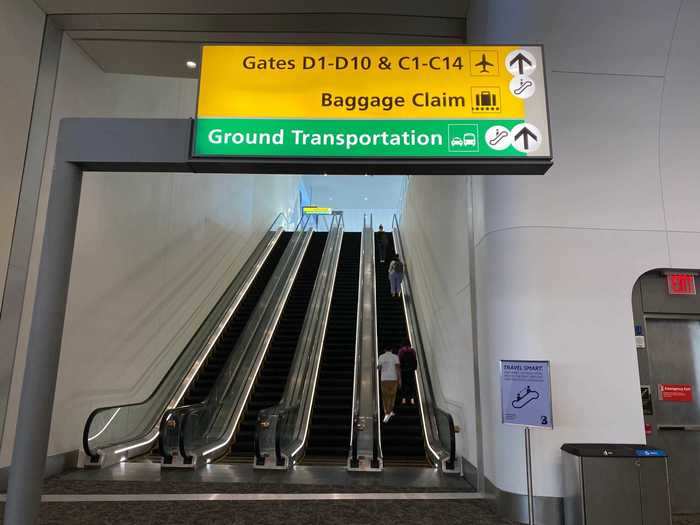
And walk across the air bridge.
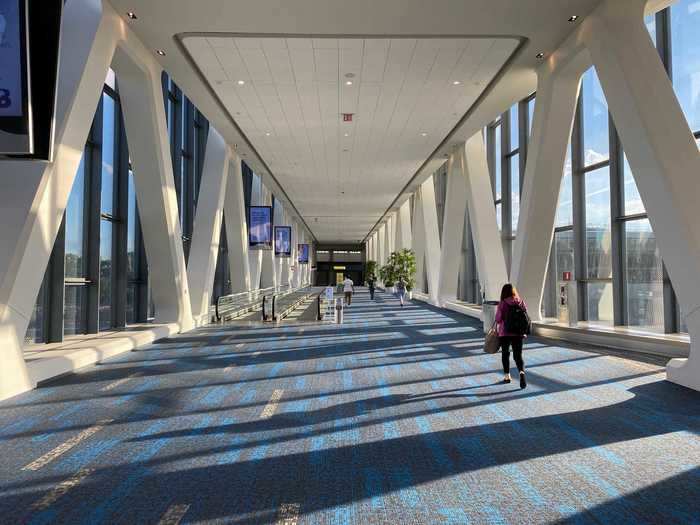
Instead of heading back to the retail space, however, I exited through glass doors with "Welcome to New York" written on the side.
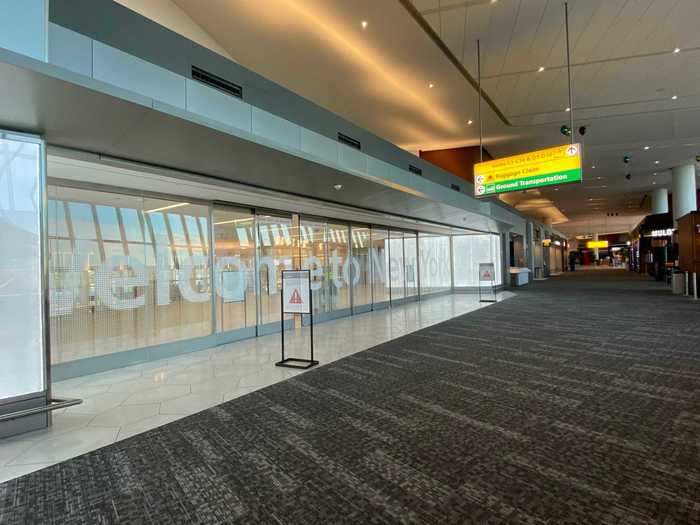
Arriving passengers are then greeted to this view of the departures hall. I wasn't the only one taking photos.
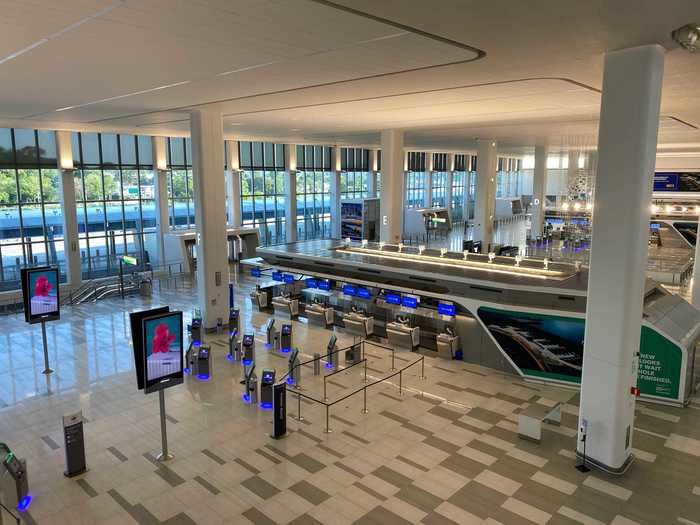
It's another two escalator rides down to baggage claim but as I only had a carry-on, I could exit at departures and head for the parking garage.
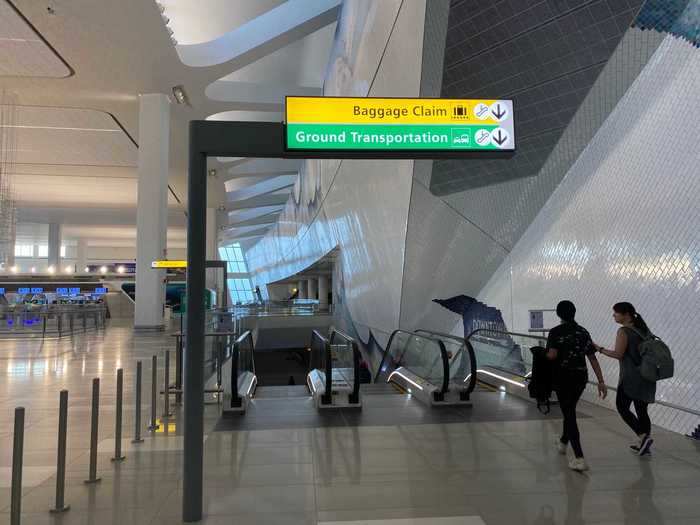
It took less than 10 minutes to get from my arrival gate to my car, and that was including stops to take photos.
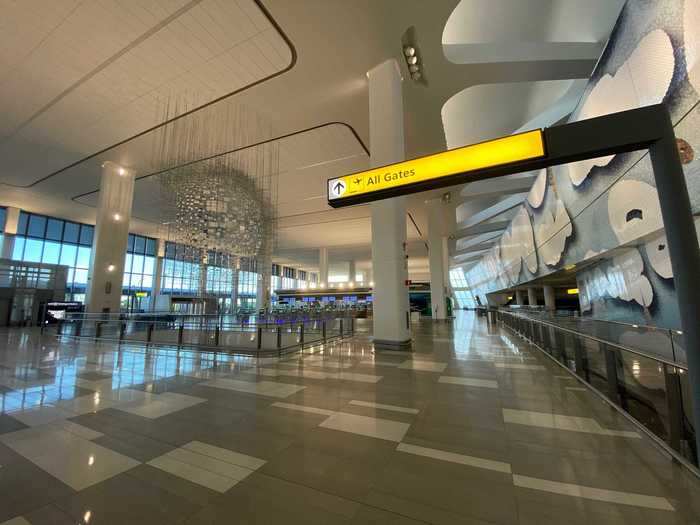
For-hire vehicles like Uber and Lyft are also met in the garage, eliminating the need to go outside at all when arriving.
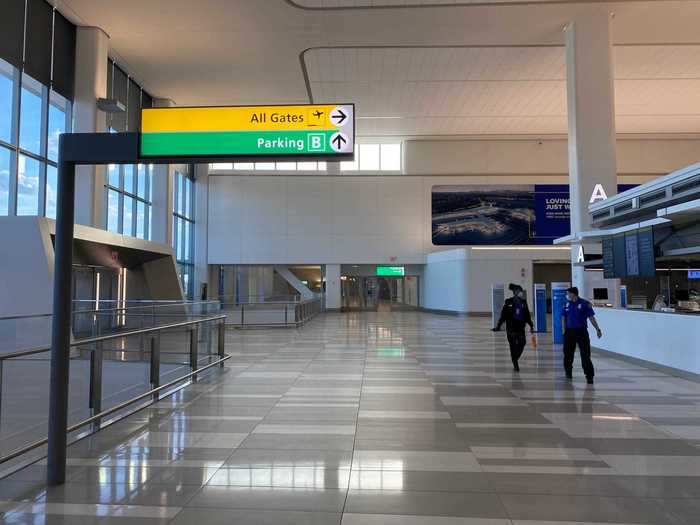
Before I knew it, I was in my car heading home. I had gone from the plane to my car without braving the elements, which I know will come in handy come winter.

The new terminal is clearly impressive and provides a much-needed upgrade for LaGuardia Airport. My favorite aspect, however, isn't just one specific feature but it's that the new facility allows the rest of the airport to shine.
Among others, LaGuardia is a small airport so taxi times are short when there are no delays and the new terminal removes a good chunk of the congestion that plagued on-time departures and arrivals. For example, passengers will no longer have to wait for the plane behind theirs to move before they can pushback and won't have to wait as long to taxi into the gate on arrival.
On top of that, it's the closest airport to Manhattan, and flying out of LaGuardia is typically more convenient than John F. Kennedy International or Newark Liberty International. Its proximity to the city also means passengers are treated to the best views of the city on arrival and departure.
The reason some travelers hated going there is that its infrastructure paled in comparison to other area airports. Now that the airport boasts modern facilities, flyers can enjoy the other understated aspects of LaGuardia.
READ MORE ARTICLES ON
Popular Right Now
Popular Keywords
Advertisement